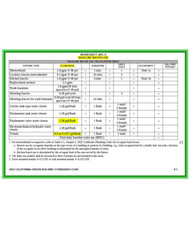Flush Valve State Restrictions: What You Need to Know
Flush valves, especially flushometers used in commercial restrooms, are key to controlling water use. In high-traffic spaces, even minor inefficiencies can lead to significant waste. That’s why many states now regulate which flush valves can be sold, installed, or used.
These state-level rules go beyond federal standards and vary widely, sometimes even by city. For manufacturers, contractors, and property owners, understanding these differences is essential.
This blog outlines where restrictions apply, what they mean, and how to stay compliant.
What Are Flush Valve Regulations?
Flush valve regulations are guidelines established by states and municipalities to ensure plumbing fixtures meet certain efficiency and performance standards. At the core of most regulations is a limit on how much water can be used per flush, often referred to as gallons per flush (GPF). These limits aim to conserve water without compromising functionality.
Many states base their standards on the federal EPA WaterSense program, which promotes water-efficient products. Toilets with the WaterSense label must use no more than 1.28 GPF and pass rigorous performance tests to ensure reliable flushing power. Although the WaterSense program itself is voluntary, numerous state and local codes have made compliance with its standards mandatory for new installations and product sales.
In addition to WaterSense, regulations often reference industry standards developed by organizations like the American National Standards Institute (ANSI) and the American Society of Mechanical Engineers (ASME). For example, ANSI/ASME A112.19.2 and A112.19.14 outline performance and safety criteria for flushometer valves and dual-flush toilets, respectively.
Some states have gone a step further by implementing their own mandatory efficiency laws. California’s Title 20 Appliance Efficiency Regulations, for instance, require toilets and flush valves to meet specific flow thresholds and be listed in the state’s appliance efficiency database. Other states, such as Texas and Washington, have adopted similar measures to regulate plumbing fixtures sold or installed within their borders.
Understanding these overlapping standards is essential. While a product may meet general performance benchmarks, it may not be legally sold or installed in certain states unless it adheres to their specific codes. For businesses and professionals in the plumbing industry, keeping up with these requirements is not only a best practice, it’s a legal obligation.
States With Flush Valve Restrictions
Flush valve regulations vary widely across the United States, with some states mandating strict water-use limits and certification requirements. Below are key examples of state-level restrictions and relevant links to official sources or summaries.
California
California maintains some of the most comprehensive regulations through its Title 20 Appliance Efficiency Regulations , enforced by the California Energy Commission (CEC). Toilets must not exceed 1.28 gallons per flush (GPF), and urinals are limited to 0.125 GPF. Any flush valve sold in the state must be tested, certified, and listed in the CEC's Modernized Appliance Efficiency Database System (MAEDBS).
Texas
Texas requires toilets sold after January 1, 2014, to use no more than 1.28 GPF on average and urinals to use no more than 0.5 GPF. These rules are outlined in House Bill 2667, which amended the Texas Health & Safety Code. Enforcement and product registrations are handled by the Texas Department of Licensing and Regulation (TDLR), and manufacturers must ensure compliance before selling plumbing products in the state.
Washington
In 2019, Washington passed House Bill 1444, requiring all plumbing fixtures sold or installed after January 1, 2021, to meet maximum flow rates equivalent to California’s Title 20 standards. Flush valves for toilets must use 1.28 GPF or less, and urinals are limited to 0.125 GPF. The Washington State Department of Commerce may test products and issue penalties of up to $250 per day for violations. Additional guidance is available via The Part Works’ summary .
Colorado
Colorado requires all plumbing fixtures, including flush valves, to be WaterSense-labeled. This applies to new construction and significant renovations under the state's green building statutes. Enforcement is carried out through local jurisdictions, making compliance essential for contractors and property developers statewide.
New York
While New York State has not adopted a uniform law equivalent to California’s Title 20, cities like New York City enforce stringent local plumbing codes. The NYC Plumbing Code sets maximum allowable flow rates and often mirrors or exceeds WaterSense standards, particularly for commercial installations and retrofits.
Massachusetts
Through its Green Communities Act, Massachusetts requires new construction and major renovations to incorporate high-efficiency plumbing fixtures. Flush valves for toilets must comply with low-GPF limits in line with national conservation standards, and municipalities may adopt even stricter requirements.
Georgia
Georgia enforces strict high-efficiency plumbing standards statewide through both statute and its amended plumbing code. According to Georgia Code § 8‑2‑3, the state prohibits the sale, distribution, or installation of any toilet that exceeds an average of 1.28 gallons per flush or any urinal that exceeds 0.5 gallons per flush. This applies to all new construction, as well as remodeling or renovation projects that involve fixture replacement. These restrictions are enforced through Georgia’s adoption of the International Plumbing Code with state-specific amendments, administered by the Georgia Department of Community Affairs. The official plumbing code also mandates high-efficiency faucets and showerheads, reinforcing Georgia’s long-standing focus on water conservation, especially in response to regional drought concerns.
Each of these states demonstrates a growing trend toward stricter water efficiency standards. Whether through Title 20 adoption, local plumbing codes, or the use of WaterSense-labeled products, jurisdictions are prioritizing conservation. Manufacturers, contractors, and retailers must ensure they understand and adhere to these evolving regulations to avoid penalties and ensure continued market access.
Penalties for Noncompliance
Flush valve regulations aren’t just guidelines - they carry real consequences. States like California and Washington strictly enforce compliance, with penalties that can include fines, market removal, and even legal action.
Selling or installing non-certified products may result in administrative citations or daily fines. In Washington, violations can cost up to $250 per day per product. California’s Title 20 mandates that flush valves be listed in the MAEDBS database; unlisted products are barred from sale or distribution.
Contractors and property owners may be required to replace noncompliant fixtures during renovations or property transfers. In some cities, failure to do so can delay inspections or lead to local code violations.
For manufacturers and suppliers, the risks extend to lost contracts, reputational damage, and exclusion from public procurement.
Staying compliant from the start helps avoid these costly setbacks and keeps your business aligned with evolving water efficiency standards.
How to Stay Compliant
Flush valve compliance isn’t complicated if it’s built into your process from the start.
Use certified products. Look for the WaterSense label or state-specific approvals, like California’s MAEDBS. These confirm a product meets local standards.
Check local codes. State rules are a starting point, but cities like New York and San Francisco often go further. Verify with local authorities or a licensed code expert before specifying or installing.
Keep documentation organized. Manufacturers and distributors should maintain up-to-date flow specs, model numbers, and certifications. Make this info easy to access, both in print and online.
Work with qualified pros. Contractors and property managers should rely on licensed plumbers who understand current codes. State boards often publish updates worth reviewing.
Track changes. Water efficiency rules shift fast. Subscribe to alerts from agencies like the California Energy Commission to avoid surprises.
By building compliance into your workflow from procurement to installation, you not only avoid fines and disruptions but also contribute to broader sustainability efforts. In today’s regulatory environment, staying ahead is not just smart business, it is a professional responsibility.
Navigating state-level flush valve regulations takes more than just good intentions; it requires the right products, clear documentation, and reliable support. Berl’s stocks a wide selection of compliant flushometers, retrofit kits, and low-flow fixtures that meet current codes in California, New York, Texas, and beyond.
Whether you're retrofitting an older building or outfitting new construction, we can help you find the right solution for your jurisdiction. Explore our flush valve collection or contact us for help with product selection and compliance documentation.


